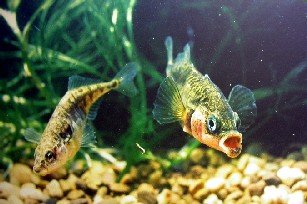The role of antioxidants in growth, signalling and lifespan
The role of antioxidants in growth, signalling and lifespan
 Participants:
Participants:
- Jan Lindström
- Neil Metcalfe
- Jon Blount
- Tom Pike
Funding:
- NERC grant to Neil Metcalfe, Jan Lindström & Jon Blount
Project Description
Project Description
It is widely accepted that there is a negative effect of current breeding effort on subsequent survival. This is usually assumed to reflect a physiological trade-off between investment in reproduction and investment in body maintenance, but this is poorly understood. In this study, we addressed the possibility that antioxidant defence might provide a causal link between sexual signalling, reproductive performance and lifespan. The sexual coloration of a male three-spined stickleback, his ability to provide parental care and the likelihood of him surviving to breed again may well be influenced by his access to dietary carotenoids.
In a combination of experimental and theoretical work we tested the effect of diet quality (specifically, the carotenoid content) on sexual attractiveness, parental care and ability to fight the rate of senescence in a short-lived species. We also explored the trade-offs between these factors influence optimal reproductive tactics for each sex.
References
References
Lindström, J., Pike, T. W., Blount, J. D. & Metcalfe, N. B. (2009) Optimization of resource allocation can explain the temporal dynamics and honesty of sexual signals. American Naturalist, 174(4):515-25
Pike, T.W. , Blount, J.D., Bjerkeng, B., Lindström, J. & Metcalfe, N.B. (2007) Carotenoids, oxidative stress and female mating preference for longer-lived males. Proceedings of the Royal Society B 274:1591-1596.
Pike, T.W. , Blount, J.D., Lindström, J. & Metcalfe, N.B. (2007) Availability of non-carotenoid dietary antioxidants affects the expression of a carotenoid-based sexual ornament. Biology Letters 3:353-356.
Pike, T.W. , Blount, J.D., Lindström, J. & Metcalfe, N.B. (2007) Dietary carotenoid availability influences a male's ability to provide parental care. Behavioral Ecology 18:1100-1105.

